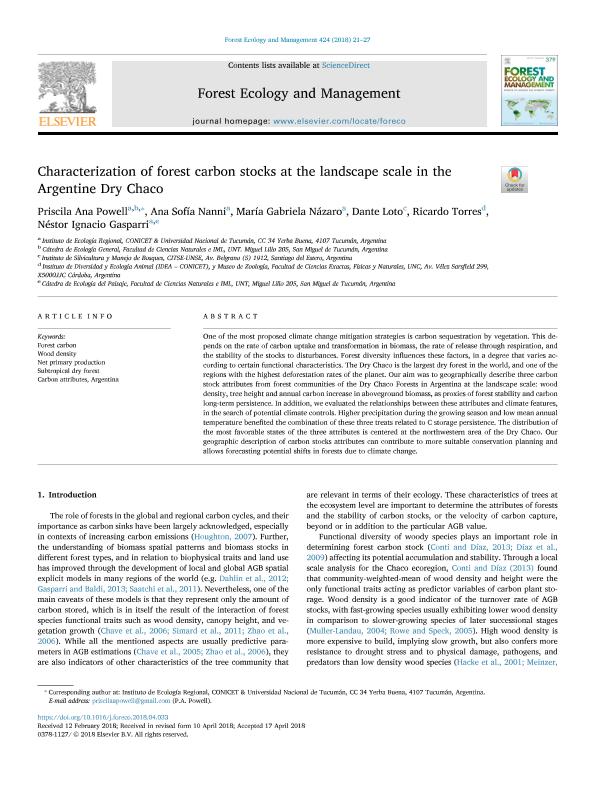Mostrar el registro sencillo del ítem
dc.contributor.author
Powell, Priscila Ana

dc.contributor.author
Nanni, Ana Sofía

dc.contributor.author
Nazaro, María Gabriela

dc.contributor.author
Loto, Dante Ernesto

dc.contributor.author
Torres, Ricardo
dc.contributor.author
Gasparri, Nestor Ignacio

dc.date.available
2019-11-25T23:30:25Z
dc.date.issued
2018-09
dc.identifier.citation
Powell, Priscila Ana; Nanni, Ana Sofía; Nazaro, María Gabriela; Loto, Dante Ernesto; Torres, Ricardo; et al.; Characterization of forest carbon stocks at the landscape scale in the Argentine Dry Chaco; Elsevier Science; Forest Ecology and Management; 424; 9-2018; 21-27
dc.identifier.issn
0378-1127
dc.identifier.uri
http://hdl.handle.net/11336/90419
dc.description.abstract
One of the most proposed climate change mitigation strategies is carbon sequestration by vegetation. This depends on the rate of carbon uptake and transformation in biomass, the rate of release through respiration, and the stability of the stocks to disturbances. Forest diversity influences these factors, in a degree that varies according to certain functional characteristics. The Dry Chaco is the largest dry forest in the world, and one of the regions with the highest deforestation rates of the planet. Our aim was to geographically describe three carbon stock attributes from forest communities of the Dry Chaco Forests in Argentina at the landscape scale: wood density, tree height and annual carbon increase in aboveground biomass, as proxies of forest stability and carbon long-term persistence. In addition, we evaluated the relationships between these attributes and climate features, in the search of potential climate controls. Higher precipitation during the growing season and low mean annual temperature benefited the combination of these three treats related to C storage persistence. The distribution of the most favorable states of the three attributes is centered at the northwestern area of the Dry Chaco. Our geographic description of carbon stocks attributes can contribute to more suitable conservation planning and allows forecasting potential shifts in forests due to climate change.
dc.format
application/pdf
dc.language.iso
eng
dc.publisher
Elsevier Science

dc.rights
info:eu-repo/semantics/openAccess
dc.rights
Atribución-NoComercial-CompartirIgual 2.5 Argentina (CC BY-NC-SA 2.5 AR)
dc.rights.uri
https://creativecommons.org/licenses/by-nc-sa/2.5/ar/
dc.subject
CARBON ATTRIBUTES, ARGENTINA
dc.subject
FOREST CARBON
dc.subject
NET PRIMARY PRODUCTION
dc.subject
SUBTROPICAL DRY FOREST
dc.subject
WOOD DENSITY
dc.subject.classification
Ciencias Medioambientales

dc.subject.classification
Ciencias de la Tierra y relacionadas con el Medio Ambiente

dc.subject.classification
CIENCIAS NATURALES Y EXACTAS

dc.subject.classification
Conservación de la Biodiversidad

dc.subject.classification
Ciencias Biológicas

dc.subject.classification
CIENCIAS NATURALES Y EXACTAS

dc.title
Characterization of forest carbon stocks at the landscape scale in the Argentine Dry Chaco
dc.type
info:eu-repo/semantics/article
dc.type
info:ar-repo/semantics/artículo
dc.type
info:eu-repo/semantics/publishedVersion
dc.date.updated
2019-10-17T13:41:58Z
dc.journal.volume
424
dc.journal.pagination
21-27
dc.journal.pais
Países Bajos

dc.journal.ciudad
Amsterdam
dc.description.fil
Fil: Powell, Priscila Ana. Universidad Nacional de Tucumán. Instituto de Ecología Regional. Consejo Nacional de Investigaciones Científicas y Técnicas. Centro Científico Tecnológico Conicet - Tucumán. Instituto de Ecología Regional; Argentina. Universidad Nacional de Tucumán. Facultad de Ciencias Naturales e Instituto Miguel Lillo. Cátedra de Ecología General; Argentina
dc.description.fil
Fil: Nanni, Ana Sofía. Universidad Nacional de Tucumán. Instituto de Ecología Regional. Consejo Nacional de Investigaciones Científicas y Técnicas. Centro Científico Tecnológico Conicet - Tucumán. Instituto de Ecología Regional; Argentina
dc.description.fil
Fil: Nazaro, María Gabriela. Universidad Nacional de Tucumán. Instituto de Ecología Regional. Consejo Nacional de Investigaciones Científicas y Técnicas. Centro Científico Tecnológico Conicet - Tucumán. Instituto de Ecología Regional; Argentina
dc.description.fil
Fil: Loto, Dante Ernesto. Consejo Nacional de Investigaciones Científicas y Técnicas. Centro de Investigaciones y Transferencia de Santiago del Estero. Universidad Nacional de Santiago del Estero. Centro de Investigaciones y Transferencia de Santiago del Estero; Argentina. Universidad Nacional de Santiago del Estero. Facultad de Ciencias Forestales. Instituto de Silvicultura y Manejo de Bosques; Argentina
dc.description.fil
Fil: Torres, Ricardo. Consejo Nacional de Investigaciones Científicas y Técnicas. Centro Científico Tecnológico Conicet - Córdoba. Instituto de Diversidad y Ecología Animal. Universidad Nacional de Córdoba. Facultad de Ciencias Exactas Físicas y Naturales. Instituto de Diversidad y Ecología Animal; Argentina. Universidad Nacional de Córdoba. Facultad de Ciencias Exactas, Físicas y Naturales. Museo de Zoología; Argentina
dc.description.fil
Fil: Gasparri, Nestor Ignacio. Universidad Nacional de Tucumán. Instituto de Ecología Regional. Consejo Nacional de Investigaciones Científicas y Técnicas. Centro Científico Tecnológico Conicet - Tucumán. Instituto de Ecología Regional; Argentina. Universidad Nacional de Tucumán. Facultad de Ciencias Naturales e Instituto Miguel Lillo; Argentina
dc.journal.title
Forest Ecology and Management

dc.relation.alternativeid
info:eu-repo/semantics/altIdentifier/url/https://www.sciencedirect.com/science/article/pii/S0378112718302780
dc.relation.alternativeid
info:eu-repo/semantics/altIdentifier/doi/http://dx.doi.org/10.1016/j.foreco.2018.04.033
Archivos asociados
